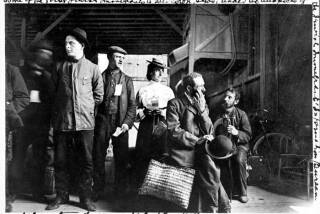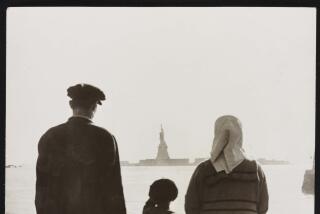TV REVIEW : Retelling an Old Story in ‘Journey to America’
- Share via
“When your grandfather came over on the boat. . . .” So the story began about our immigrant relatives, and in the back of our young minds, we had to wonder if it was all true. Memories color, exaggerate and romanticize the past, which is why we need history. Award-winning documentary film maker Charles Guggenheim appears to have been so taken by his own family’s immigrant story, as well as the need to visualize history, that he has made a small career out of the subject.
First was “The Making of Liberty,” for PBS, about the creation of the Statue of Liberty, the symbol of immigrant hope. Now, he has assembled and edited what must have been endless miles of archival footage into “Journey to America,” for PBS’ “The American Experience” (tonight at 10, Channel 28). The romance is gone; all that is left is cold, hard history.
The reasons for making the journey to America were far more complex than simply an escape from poverty. With a minimum of voice-over narration and a maximum of voice-over by the immigrants themselves (well over a dozen were interviewed), Guggenheim shows that sheer adventure and freedom of religious belief drove people here as much as the desire to make a buck. Still, the images of grinding degradation on the plains of Eastern Europe, contrasting with the splendor of the first view of the Manhattan skyline, speak volumes about America’s real and projected identity as the land “where the streets are paved with gold.”
Underlying everything in the film is a drama that has now fairly much played itself out in American life--class struggle. The poor immigrant rode like a sardine in the ship’s steerage section. If he wasn’t identified as unacceptable for political or health reasons, he made it through the vast Ellis Island processing facility--likely with a new Americanized name given him by a customs official.
Then, if he was lucky, he landed a job in the New York ghettos, or the huge Chicago slaughterhouses, or the mines of Appalachia or the Far West, where his son worked alongside him. It was in these conditions that a radicalized socialism took root in America, but this is a chapter of history Guggenheim omits.
Not omitted is the fact that seven-day work weeks, 10 people to a single apartment and general discrimination against the new immigrants dissolved their own ethnic and nationalist differences, despite the urge to re-create the old country in the new cities. They became Americanized. Today’s popular fears of Third World immigration look, in light of Guggenheim’s film, like a sad repeat of an old story.
More to Read
The complete guide to home viewing
Get Screen Gab for everything about the TV shows and streaming movies everyone’s talking about.
You may occasionally receive promotional content from the Los Angeles Times.






